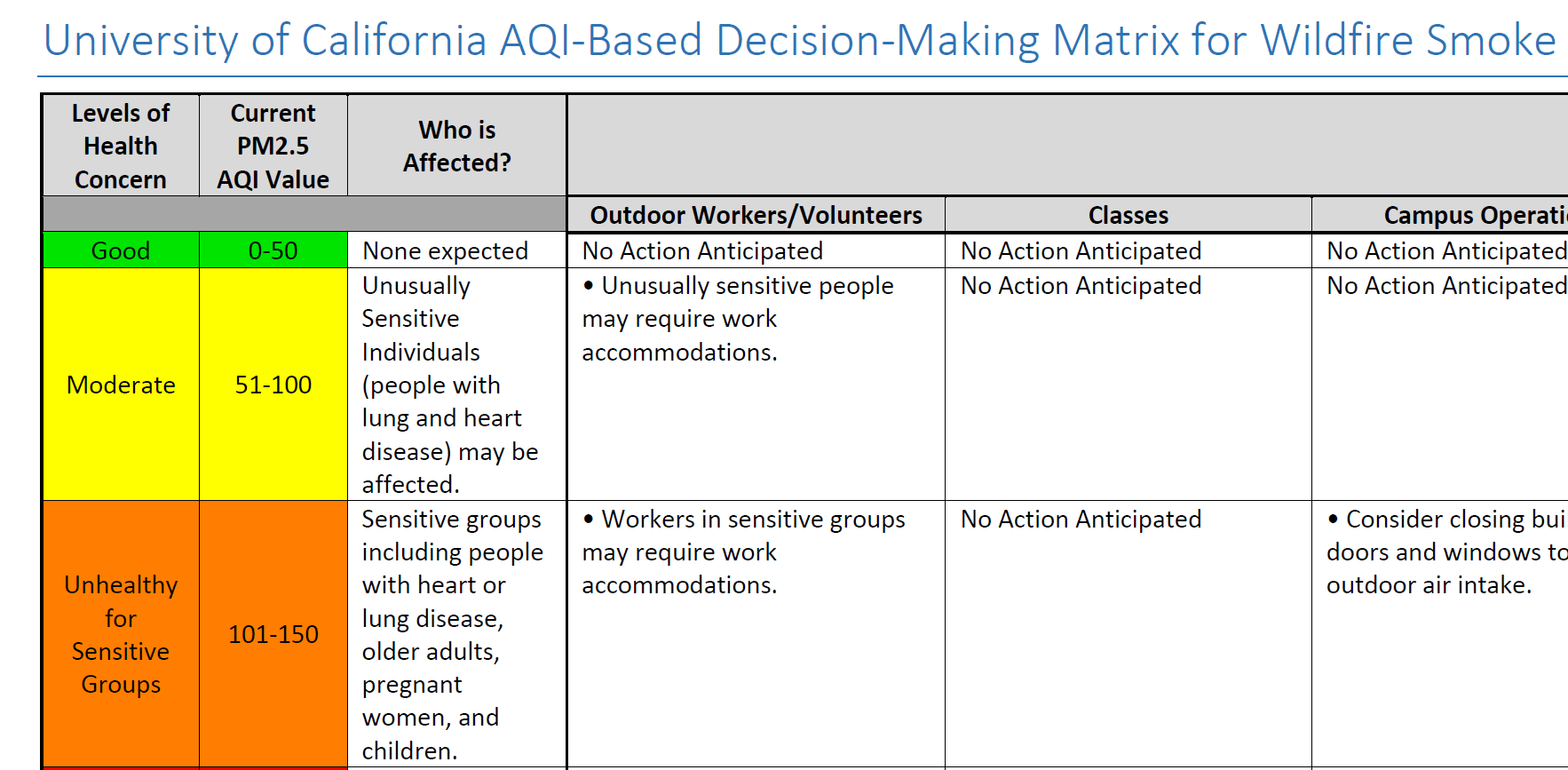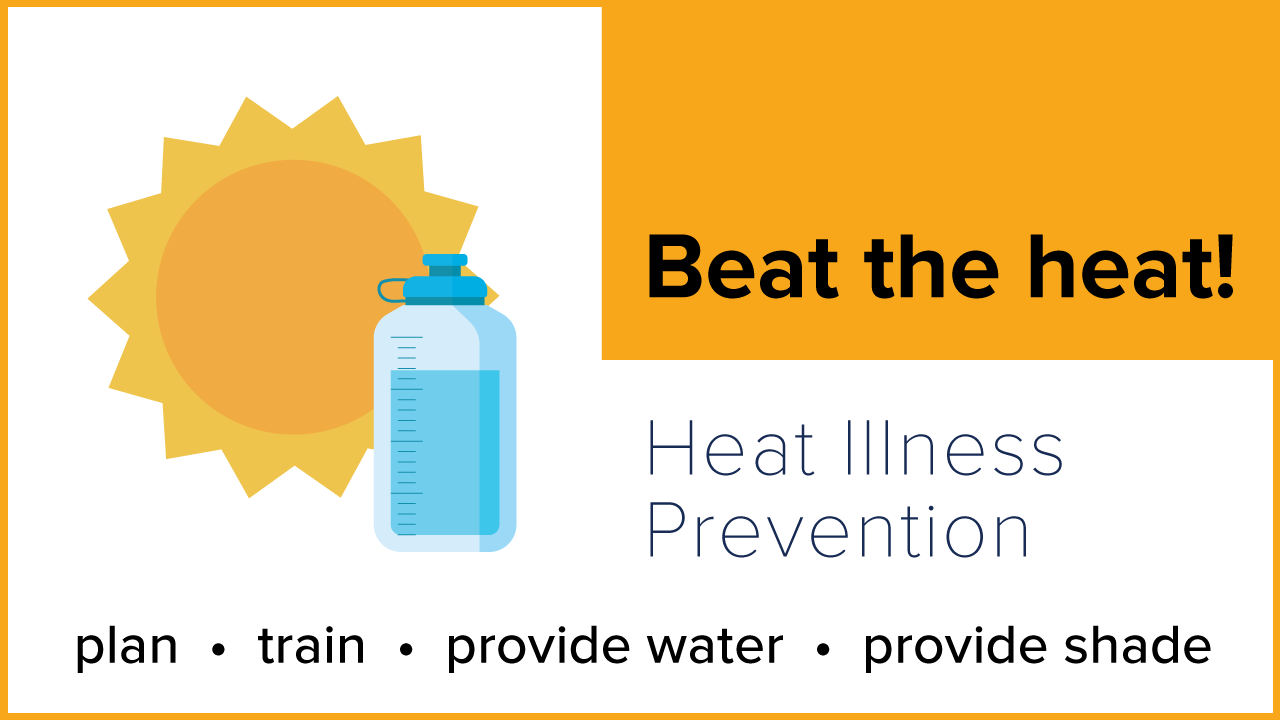UC Davis employees and students must prioritize their safety and well-being while working outdoors, conducting field research and working at heights, potentially in the heat and wildfire smoke.
Proper planning will minimize risks to you and ensure the success of our work and research.
Topics Below
1. Wildfire Smoke and Outdoor Workers
2. Field Safety Planning and Preparation
3. Fall Protection Planning
4. Heat Illness Prevention
Wildfire Smoke and Outdoor Workers
The threat of severe wildfires in California requires awareness and preparedness for anyone working outdoors.
Tuesday, May 21
1 - 2 p.m. (updated)
Join via Zoom
We'll discuss planning and resources to protect outdoor workers from wildfire smoke:
- CalOSHA emergency standard CCR 8 §5141.1 Protection from Wildfire Smoke ensures protections for outdoor workers and field researchers.
- Decision Matrix Based on Air Quality prescribes actions when wildfire smoke produces unhealthy air quality.
- Providing appropriate and effective respirators when the employer reasonably expects employees will be exposed to wildfire smoke.
- Latest developments in CalOSHA emergency standard
- Options for ensuring protection from wildfire smoke for outdoor workers

Air Quality Index Decision Matrix
The Decision Matrix Based on Air Quality is designed for use when wildfire smoke conditions result in worsening and unhealthy air quality. It does not apply if there is a direct threat of wildfire and/or other significant hazard to the location, or for smog-related air quality conditions.
>> Learn More
Building Ventilation and Filtration
It is critical to keep doors and windows closed when it's smoky outdoors.
- Learn how Facilities Management manages campus ventilation and filtration systems to reduce the impact of wildfire smoke.
Get N-95 Masks
Review your departmental supply of N-95 masks for outdoor workers and have enough ready to maintain operations through two weeks of smoke conditions. Test your communications plan before an emergency to notify your outdoor workers when a smoke event is coming and how to pick up a mask for voluntary use.
- Purchase on AggieBuy
- Purchase at the Scientific Store at 650 La Rue Rd (limited on-site supply)
- Questions? Contact ab-help@ucdavis.edu
Field Safety Planning and Preparation
Your safety planning should start well before you expect to begin working in the field. We can help!
Wednesday, May 22
11 a.m. - Noon
Join via Zoom
We'll cover important elements of field safety planning:
- Refresher on field safety resources and field safety planning tool
- Key elements of the field safety plan and communications plan
- Driving off road and safety imperatives
- Creating a safe and inclusive working environment for off-site research to prevent harassment, bullying, and other unwelcome conduct.
Contact FieldSafety@ucdavis.edu for help
Field Safety Training

- Wilderness first aid
- Tailored workshops
Equipment Loans

- Satellite communicators
- First aid kits
Guidance

- Field safety plan consultation/review
Top 5 Field Safety Concerns
Some heightened threats to anticipate in the field in 2024
- Water flowing fast and cold from mountain runoff
- Erosion and rock fall in areas that have burned
- Hazard trees that have been compromised by drought, fire and insects
- Ticks and mosquitoes will be abundant
- Post-fire regeneration and weeds can include highly flammable vegetation
Learn More About Field Research Planning
Fall Protection Planning
Employers need to ensure worker safety in situations where falls – even from seemingly insignificant heights - could still result in serious injuries. Taking steps to prevent employee falls is required for anyone working at heights, and in some cases the trigger height for fall protection is as low as 30 inches.
The UC Davis Fall Protection Plan has been rewritten to offer clear guidance to anyone responsible for preventing worker falls in the workplace.
Thursday, May 23
11 a.m. - Noon
Join via Zoom
Join a webinar covering key components of a comprehensive fall protection plan:
- Hazard Assessment: Identification of potential fall hazards in the workplace, such as unprotected edges, floor openings, or elevated work surfaces.
- Roles: Understand the important roles of an Authorized, Competent and Qualified person in preventing worker falls.
- Fall Prevention Measures: Implementation of measures to prevent falls, such as guardrails, safety nets, or personal fall arrest systems (PFAS).
- Budgeting: Departments need to budget for training, as well as the purchase and timely replacement of safety equipment.
- Training: Proper training for workers on fall hazards, how to properly use fall protection equipment, and emergency procedures.
- Equipment Inspection and Maintenance: Regular inspection and maintenance of fall protection equipment to ensure it is in good working condition.
- Rescue Plan: A plan for rescuing workers in the event of a fall, including procedures for prompt response and medical assistance.
- Documentation: Keeping records of hazard assessments, training sessions, equipment inspections, and any incidents or near misses related to falls.
Limited space will be available and will be discussed at this training.
Heat Illness Prevention
Now is the time for departments with outdoor workers or researchers to prepare for the risks of heat exposure and to be aware of heat illness prevention. High-heat procedures must be enacted when the temperature rises over 95 degrees Fahrenheit.
Additionally, Cal/OSHA has proposed regulations for indoor heat illness prevention that could impact new areas and professions like, IT and food service professionals, animal care and greenhouse technicians, and anyone working indoors where temperatures could reach 82 degrees Fahrenheit.
Friday, May 24
11 a.m. - Noon
Register via Zoom
We'll discuss the four steps to preventing heat illness:
- Planning - Develop and implement written procedures for complying with the Cal/OSHA Heat Illness Prevention Standard.
- Training - All staff and researchers engaged in outdoor work must complete the Heat Illness Prevention Training annually.
- Water - Provide enough fresh water so that each employee can drink at least 1 quart per hour, and encourage them to do so.
- Shade - Provide access to a shaded area to prevent or recover from heat illness and where employees can take rest breaks.

Heat Illness Prevention Procedure Manual
For UC Davis departments to use in establishing and implementing a heat illness prevention program.
>> Learn More
